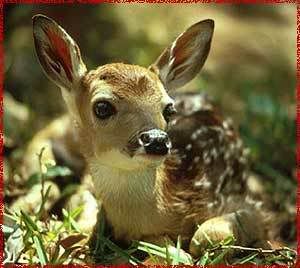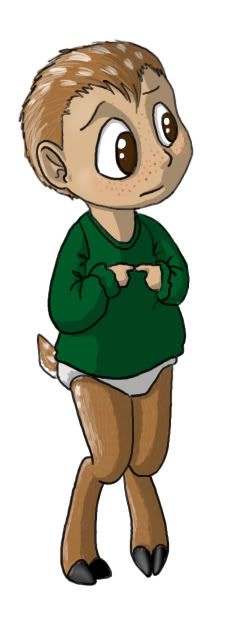
The Virginia Deer is also known as the White-tailed Deer.  Description:
Description:The deer's coat is a reddish-brown in the spring and summer and turns to a grey-brown throughout the fall and winter. The deer can be recognized by the characteristic white underside to its tail, which it shows as a signal of alarm by raising the tail during escape. Males one year of age or older have antlers. However, some bucks may have small antlers, some small enough to have their antler pedicles hidden in the hair, making them look like a doe. Antlers begin to grow in late spring, covered with a highly vascularised tissue known as velvet. Bucks either have a typical or non-typical antler arrangement. Typical antlers are symmetrical on both sides and the points grow straight up off the main beam. Non-typical antlers are asymmetrical and the points may project at any angle from the main beam. Bucks shed their antlers when all females have been bred, from late December to February.
Behavior:Whitetails communicate in many different ways including sounds, scent, and marking. All whitetail deer are capable of producing audible noises, unique to each animal. Fawns release a high pitched squeal, known as a bleat, to call out to their mothers. Does also bleat, as well as grunt. Grunting produces a low, guttural sound that will attract the attention of any other deer in the area. Both does and bucks snort, a sound that often signals danger. As well as snorting, bucks also grunt at a pitch thats gets lower with maturity. Bucks are unique, however, in their grunt-snort-wheeze pattern that often shows aggression and hostility.
Deer are extremely cautious animals with keen senses of smell and hearing. Both White-tailed and Mule deer can run as fast as 40 miles per hour and are good swimmers. The basic social unit is a female and her fawns, although does have been observed to graze together in herds of up to hundreds of individuals. Except for the mating season, bucks and does remain apart. Bucks generally live alone or in small groups with other bucks, while does live alone or with their fawns and female yearlings.
When deer detect a potential threat all of their senses are directed toward that area of concern. The deer assumes a posture that includes the cocking forward of both ears. The deer is prepared to fight or flee. Should the potential threat continue, or if a deer is unsure as to the actual presence of a threat, it will usually stomp a forefoot in an effort to evoke a response from the unknown object. Other deer in the immediate area are then warned of the possibility of danger. Repeated foot stomps readily occur, probably for the same purposes as already mentioned. If or when the threat is identified as danger, deer will erect their tails, providing another cue to other deer of the imminent danger.
Habitats and Habits:Deer generally prefer open woodland, but are often found on the fringes of urban areas and in farming country, but desert species can occur in most habitats within 10 miles of a water source. They often enter human inhabited areas and feast on flowers and grass as well as regularly getting a drink from man's abundant water supplies. Some deer have also taken to eating garbage and plastic which is not at all good for them.
White-tail deer feed on a variety of vegetation, depending on what is available in their habitat. They are browsers feeding on twigs, leaves, bark, shrubs, the fruits and nuts of most vegetation, as well as lichens and other fungi. In desert areas, plants such as huajillo brush, yucca, prickly pear cactus, comal, ratama and various tough shrubs may be the main components of a White-tail's diet. Conifers are often utilized in winter when other foods are scarce. White-tail deer feed mainly from before dawn until several hours after, and again from late afternoon until dusk.

















